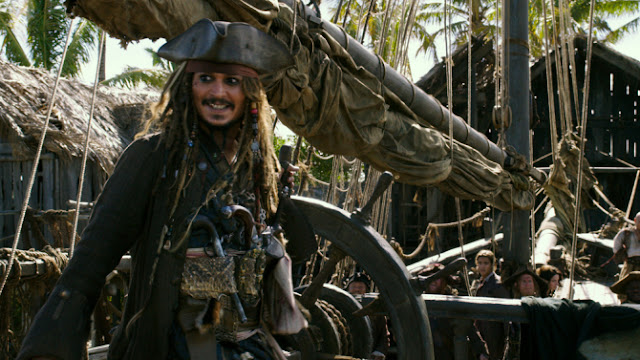Waralaba "Pirates of the Caribbean" mengarah ke jalur kelima yang menjemukan ini.
When Disney
first announced plans to build a feature film out of its venerable Pirates of
the Caribbean ride, there was little reason to expect anything more than a grab
for quick cash and a few Disneyland
cross-promotional opportunities. To just about everyone’s surprise, Gore
Verbinski’s 2003 “Pirates of the Caribbean :
The Curse of the Black Pearl” was an inspired piece of old-school popcorn
entertainment; more clever, more fun, and fundamentally riskier than it had any
right to be.
Now, 14 years
and four films later, the “Pirates” franchise has finally delivered exactly
what cynics had expected all along. Containing only the faintest traces of the
spark that turned this once unpromising idea into a nearly four billion-dollar
enterprise, Joachim Ronning and Espen Sandberg’s “Pirates of the Caribbean : Dead Men Tell No Tales” is a mercenary,
visually unappealing exercise in brand maintenance. The franchise has lost a
bit of its luster with every successive installment, but never has a “Pirates”
film felt this inessential, this depressingly pro forma. It will surely make
money, and the estimated wait times for its namesake ride will spike in Disney
parks worldwide. But considering the quality of some of the other big-money
franchises in Disney’s fleet, “Pirates” needs to make a far better case for its
seaworthiness if it expects to see future voyages.
After the
triumph of “Black Pearl,” the two Verbinski-directed sequels grew ever more
bloated and obsessed with their own cod-mythology as they went; the fourth film,
directed by Rob Marshall, reined in some of its predecessors’ more lumbering
tendencies, yet seemed to leave the franchise with nowhere to go. Hence, the
studio has resorted to a “soft reboot,” which in this case means mimicking the
structure and story beats of the series’ first installment, with markedly
diminished returns.
Once again
serving as both protagonist and comic relief, Johnny Depp reprises his role as
drunken, dissolute, sporadically decipherable pirate Captain Jack Sparrow. His
performance here is no better and no worse than in his previous two or three
outings, though what once was a bracingly anarchic approach is starting to feel
a bit old hat, like a standup comic rehashing vintage punchlines for cheers of
recognition, rather than laughs.
(One hesitates
to delve too deeply into Depp’s offscreen scandals, but a key factor in
“Pirates’” success was the way Sparrow both melded with and exemplified Depp’s
early-2000s reputation as Hollywood’s most beloved iconoclast. Now that his
public image is less rosy, audience indulgence of his idiosyncrasies might be
less forgiving.)
Once again,
Sparrow begins the film attempting a heist, and subsequently facing imminent
execution at the hands of some dour British soldiers. And once again, he makes
the acquaintance of two straight-arrow youngsters. This time, his sidekicks are
Henry Turner (Brenton Thwaites), son of the first trilogy’s Will Turner
(Orlando Bloom) and Elizabeth Swann (Keira Knightley); and Carina Smyth (Kaya
Scodelario), a defiant, proto-feminist astronomer accused of witchcraft. The
film gives these two precious little to play, but considering their broad
physical resemblances and virtually identical character types, it’s hard not to
compare Thwaites’ and Scodelario’s performances to Bloom’s and Knightley’s in
the first “Pirates,” and the comparison does them no favors.
Succinct
plotting has never been among the “Pirates” films’ virtues, so suffice it to
say that all three have various reasons to seek the film’s central MacGuffin:
The Trident of Poseidon, which has the power to undo curses. Standing in their
way is a fearsome band of undead Spanish sailors lead by “el matador del mar,” Captain
Armando Salazar (Javier Bardem), who is soon joined by Sparrow nemesis Captain
Barbossa (Geoffrey Rush). Subjects of the film’s most striking visual effects,
some of Salazar’s partially mutilated ghouls look terrifying, while others look
like incompletely-buffered Playstation 2 characters.
Lackluster as it
is, “Dead Men Tell No Tales” is not an aggressively unpleasant time at the
cinema. An early scene featuring an unusually literal bank robbery is well
staged and entertaining, establishing a high watermark of spectacle that the
film never again threatens to reach. The luminous Iranian actress Golshifteh
Farahani hams it up enjoyably as a heavily henna’ed witch. Paul McCartney has a
bit part as a pirate named Uncle Jack, which is fun in the sense that it makes
you stop and think, “hey, that’s Paul McCartney.” Buckles are swashed, and do
is derred.
But rarely is
one ever swept up in the sanitized pirate fantasy that used to be the
franchise’s raison d’etre – indeed, were it not for the occasional wide shots
of the digitally-sweetened ocean, it would be easy to forget the film even
takes place on the water. This is strange considering Ronning and Sandberg’s
previous film, the Oscar-nominated “Kon-Tiki,” was set almost entirely on a
boat, skillfully relying on tiny sonic details and slightly off-kilter angles
to suggest a life at sea. Strikingly little of that sensibility survives here:
Shot in Australia ,
“Dead Men Tell No Tales” rarely appears to be taking place anywhere other than
a soundstage, featuring pirates posed against unnaturally hued skies, and a
foggy color palette that ranges from gray to slate, gunmetal, granite, and ash.
One hopes the
directors plundered enough booty on this excursion to quickly get back to what
they do best. As for the series, it’s taking on water fast.

Komentar
Posting Komentar